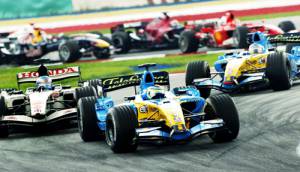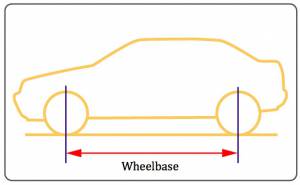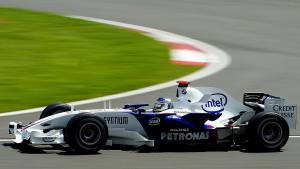In the spring of 2002, George Stratis was a junior majoring in Computer Science and minoring in Peace and Conflict Studies at USC.
In order for the Formula One industry to produce some of the fastest cars in the world, art, science, and engineering must find common ground. Fierce competition and numerous regulations necessitate new design approaches in order to gain the few milliseconds that can separate the winners from the losers. Designers, engineers and computer scientists utilize the latest computer aided design technology in an effort to create the perfect racing machine.
Introduction
Every other Sunday, from March to September, more than 40,000,000 people partake in the excitement of the Formula One Grand Prix. Attracting worldwide attention to its host country, the race has taken place throughout Europe, Australia, Japan, Brazil, and the United States. Since its beginning in the twentieth century, Formula One racing has grown in popularity commensurate with most other international sporting events today (see Fig. 1).
From the expensive sports cars on the streets to the futuristic machines in the movies, fast cars enliven the imagination. Earnest fans around the world watch the Grand Prix religiously, even if the difference in time zones requires live viewing at 2am. While many follow the races and relish the excitement it engenders, far fewer understand the engineering behind these mammoth works of art. They are some of only a few machines weighing as much as 600kg while able to reach velocities of more than 200 miles per hour. The production of a Formula One racing car is a fine example of the subtle combination of art and engineering.
The design and construction of a Formula One car requires the collaboration of a diverse design team. Aesthetic designers, computer scientists and engineers must settle on common ground to develop highly interrelated machinery in a coherent and coordinated manner. It is not uncommon for Formula One cars to have multi-million dollar budgets. With such resources, limited time frames, and the knowledge that victory and failure rest a few milliseconds apart, these professionals work as a team to produce their finest work.
Beginnings
Each year the handful of teams that participate in the Formula One circuit design a car from scratch, able to perform in a continuously evolving and highly competitive environment. The manufacturers only receive three months of off-season time. Such time-limited operation requires excellent management and team work. Usually one manufacturer designs the car chassis while another is in charge of the engine. It may seem counterintuitive to design such critical components independently, but with proper coordination, models can fit perfectly the first time the car is assembled. It is crucial to “avoid any misunderstandings that often take place when experts of different domains…have to find a common language to transfer knowledge” [1]. However, the development cycle is initiated long before manufacture begins.
The Drawing Board
Beginning with concept sketches, the team develops a small number of preliminary designs, only one of which is selected for the final car. The aesthetic designers “are responsible for, and control, the early stages of the process and then hand over the design to engineers for analysis, making it ready for production” [2]. In the early days of Formula One racing, designers would use pencil and paper to produce rough sketches of the car. Only by week three of the process would a three-dimensional representation of their design become available through a clay or foam model for further consideration [2].
By the late 1980s, designers realized that a more efficient strategy was to use computer aided design (CAD) tools. CAD enabled the concept design process to speed up, leading to presentable ideas earlier in the development cycle. Today, a hybrid approach utilizing CAD models and hand drawings is used by most manufacturers.
In this manner, the aesthetic designers can work with the ease and flexibility of the traditional process while taking advantage of new technologies for “rapid production of solid models after the initial concept drawing phase” [2]. Using application-specific software, designers can digitize their drawings and “glue” them to a three dimensional model of the car to produce a visual representation that will help the team decide which design they will develop. To understand this approach, consider a plain, plastic doll house. If one creates the door, windows, and roof on regular paper, and glues them to the surface of the house, the model becomes more realistic. Designers sometimes use this same principle to generate three dimensional modes of the car they envision on their computers.
Technology has enabled designers to explore more concepts in less time and with reduced costs. Once a final selection is made, the design is given to the engineers, who must add to it functionality.
Are Looks Everything?
While Formula One cars can look “cool,” beauty alone doesn’t win races. The operative word in Formula One is formula–teams cannot simply make cars bigger and faster to win the championship. Each must abide by a formula which creates a well-defined framework. Teams must operate within these constraints while taking advantage of every possible optimization to bring their car to the leading edge. Three main categories of limitations describe the formula that is the namesake of the sport.
The first outlines physical limitations. The standards are set so that large engines and big budgets aren’t enough to ensure a trophy. To illustrate the motivation for this, consider the excitement of track events if runners were allowed to use steroids or devices to help them run faster. The standards for Formula One cars include major design restrictions, such as engine capacity and total mass, but also extend to such limiting details as the width of the chassis layers and the wheelbase (see Fig. 2).
The second category limits technological aid. The Formula One circuit has chosen to keep the teams from automating the cars to the point where the driver is merely an accessory, as opposed to actually controlling the car. In 1992, Formula One banned computer controlled launch control that optimized acceleration from rest by regulating engine power, clutch release and gear shifting. If such were allowed, the driver would need only to floor the accelerator, and the black box would to the rest [3]. For analogous reasons, Formula One officials also eliminated traction control and automated suspension systems.
The last category is comprised of safety standards. Many safety-related constraints are imposed on manufacturers. They were adopted to protect the drivers, particularly after 1994 when a horrific accident killed Ayrton Senna, whom some consider the greatest driver in the history of the circuit. This event prompted major modifications to the regulations: reducing engine size, increasing body weight and reducing downforce (the force which keeps the car on the road).
The Task of the Engineer
With such mandates in place, engineers face a difficult task as they design the technical features of the car. They must consider the regulations and implement the design chosen by the aesthetic designers and produce (after numerous optimizations) a car with the characteristics to compete with and outrace the competition.
Approximation models are used to simulate a car’s physical behavior so that engineers can detect problems before precise models are built. This method increases throughput by up to 1000 times over previous methods, enabling complex optimization tasks common to vehicle engineering [4]. For example, engineers can optimize the downforce without significantly changing car shape, which would dramatically alter other characteristics.
Engineers must decide on every precise detail before the car is manufactured. To this end, knowledge-based design is used and the overall assembly is divided into smaller, simpler subassemblies, on which different engineers can work independently. Object-oriented modeling software allows engineers to “compare performances and different attitudes of the car while changing properties and configuration of the subsystem upon which the study [is] focused” [1].
Each of the above techniques allows engineers to work with the aesthetic designers without losing precious time. Optimization software finds solutions to complex tradeoffs without compromising the style and performance of the car, while maintaining safety and design limitations [5]. The car is then built and made ready to hit the circuits and compete for the World Championship.
Continuous Design Modifications
Unexpected changes like driver substitution can dramatically affect car performance mid-season. This and other sudden changes like climate concerns in the host country demand continuous fine tuning. Every variable is considered in hopes to that extra hundredth of a second per lap which might result in a place at the winner’s podium.
The first problems are usually solved at the beginning of the season. No matter how carefully controlled tests are performed, they are never perfect. A reduced size model in the manufacturer’s wind tunnel may not reveal minor problems the full size car may have. These problems are dealt with as they are discovered. After this point, the teams rely on two main sources for information. First and foremost, the driver is always an integral part of the technical briefings and is the best source for understanding the car’s on-track behavior. The driver usually has the technical skills and experience to tell engineers about problems that cannot be understood in blueprints or simulations (see Fig. 3).
The other source of information is the car itself. Each Formula One car is filled with chips that monitor each subsystem of the car and produce about 2MB of data per lap, for an astonishing 1GB of information from qualifying rounds to finish [3].
The car sends real-time information to the team’s computers at the pit. In this manner, the crew receives information about the car’s behavior, potential problems and hints about changes that will bring the car closer to perfection. Circuit regulations allow for one-way communication only. That is, the pit crew cannot send information to the car. This rule is enforced to ensure the driver is the only one in control of the car.
Conclusion
Year after year Formula One cars evolve to improve on-track performance. At the season’s end, each team hopes to have its driver at the top of the driver’s championship, and the manufacturer at the top of the manufacturer’s championship. With a constant effort to tailor the car to the driver and the circuit, the team’s engineers never stop working to create the ideal racing machine.
References
-
- [1] L. Susca, F. Mandorli, C. Rizzi and U. Cugini.”Racing Car Design Using Knowledge Aided Engineering”. Artificial Intelligence for Engineering Design, Analysis and Manfacturing, vol. 14, pp. 235-249. 2000.
- [2] M. Tovey, and J. Owen. “Sketching and Direct CAD Modeling in Automobile Design”. Design Studies, vol. 21, pp. 569-588, 2000.
- [3] T. Baer. “Designing for Formula One Racing. Mechanical Engineering”. CIME, vol. 117, pp. 94-98, 1995.
- [4] M. Gobbi, G. Mastinu and C. Donicelli. “Optimizing a Car Chassis”. Vehicle System Dynamics, vol. 32, pp. 149-170, 1999.
- [5] M. Beccaria, G. Buresti, A Ciampa, G. Lombardi, W. Gentzsch, H. Paap, and A. Vicere. “High-Performance Road-Vehicle Optimised Aerodynamic Design: Application of Parallel Computing to Car Design”. Future Generations Computer Systems, vol. 15, pp. 323-332, 1999.






